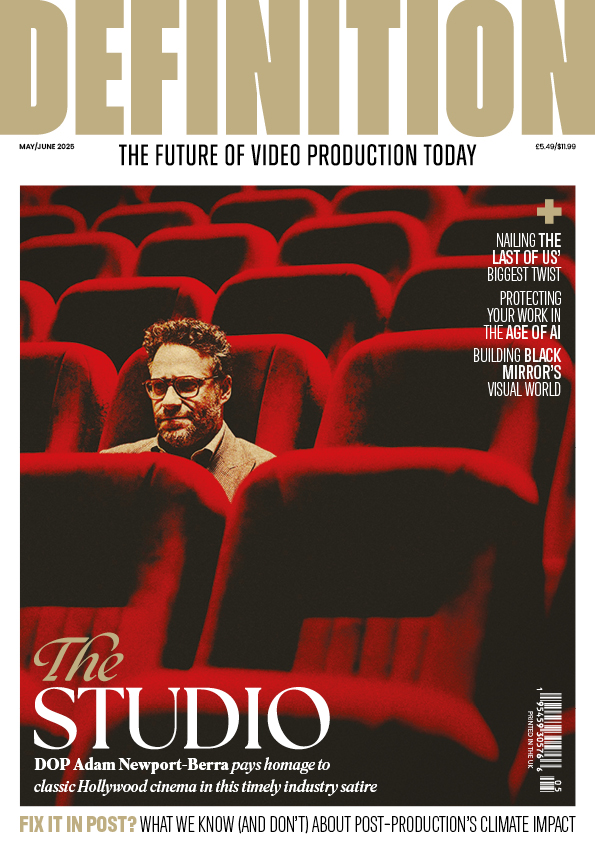
5G: A new dawn of connectivity
Posted on Jan 14, 2022 by Alex Fice
The widespread launch of fifth-generation mobile network technology is on the horizon, but what does it mean for the world of production?
Words Lee Renwick
Some technologies arrive and revolutionise their sector instantaneously. Others do not. When we consider 5G as a new offering that relies upon the roll-out of advanced global architecture, it’s easy to imagine which category it falls into. In fact, it’s been in development for over six years now, and the world saw its first usage in 2019 – albeit in a very limited capacity.
There’s no exact timeline as far as ubiquitous 5G coverage is concerned, but film and television production is a forward-thinking industry. It’s no surprise certain key players have been exploring the potential – there’s no such thing as ‘too soon’ when it comes to advancing tech. Through digital sensors, the rise of LED, HDR workflows and virtual production, we’ve seen it time and time again – those who dive in early are likely to make the biggest waves.
In the clouds
“I anticipate 5G will be part of many solutions, but I think it will have to be a multi-threaded approach, where the network is used alongside hard-wired connections and tools like Starlink,” says Tom Mitchell, technical director at Mission Digital and former DIT. “Alone, coverage is not consistent and, if you’re a long way from the cell tower, bandwidth might be limited.
“Satellites like Starlink interest me particularly. In any open-air space, you’ll have coverage, so the only question mark from the ground up is, how much bandwidth can a single unit get?”
On that front, 5G is designed to be capable of one thing its predecessors were not – in foresight of its virtually limitless use across countless industries, no doubt.
“There’s a unique protocol that enables companies to make their own 5G networks. With stages 400 to 500 yards away from each other, you could potentially transmit fairly high-bandwidth camera data from one to the next.”
What about those not sitting a stone’s throw from the principal crew on-set, like the VFX team or editors? The hands-on section of their workflow – the editing or effects – has been done in the cloud for some time. But the same can’t be said for getting set up.
“VFX pulls and the delivery of dailies are still done in person,” Mitchell explains. “With 5G, we’re approaching what some have called ‘camera to cloud’.
“Our developing platform, Origami, is the first to provide pulls for VFX vendors, and it’s done using Amazon S3 storage.
“Right now, on a project where 90% is staged, we’re able to put in a 10Gb connection and essentially provide a camera-to-cloud workflow. When 5G is here, it’ll open up the same opportunity to location-based productions. It won’t be long before we can provide other services up the chain.”
Talent on-set
The importance of a faster workflow must be considered in financial terms. Productions wrapping sooner means they’re sold sooner, freeing up invested capital for the next project and making more immediate returns.
As if bringing set and post-production closer together than ever isn’t enough, Mitchell believes the potential doesn’t stop there.
“There are direct savings to be made with automation, through a lack of costly human error. But 5G will also deliver more tools. Cloud potential is humongous, and AI is set to be more than a buzzword.
“You could use it for facial recognition, so teams can immediately find all shots with a particular actor in it, for example. Those kinds of tools can be put in place, because we won’t simply be handing files over on hard drives.
“If we take the journey of a VFX artist, they do days of admin before finally sitting down to create art. But what if they could just get to it? Well, 5G is one of the elements that will make that world a reality.”
Mitchell explains a great deal of ‘filtering’ will need to be done on-set, to ensure the correct data is fed into the AI machine. That will be part of the evolved role of the DIT. It also makes pre-production more integral than ever.
But what of other creative roles, so far uninvolved in cloud workflows? They are set to benefit hugely from more advanced versions of what are most likely in their pockets already.
“We’re going to see more digital interconnectivity between departments. And more shared knowledge across one giant network, where we don’t have to duplicate information as we do now,” Mitchell says. “Costume, makeup, production designers and more will have their own personal playback devices, where they can take screenshots, draw, make notes, then send that back to their team to prepare for tomorrow’s scene – all with essentially zero latency.
“If we can find ways of making the flow of information as efficient and seamless as possible, it only greases the wheels of creativity.”
And we’re live!
Much of the current discussion about 5G within the industry is educated speculation, but few have actually tested the new tech’s mettle. One project that has is Live + Wild, a consortium of Candour Productions, AQL and MTN Safety.
We explained to AQL early on that we’re documentary filmmakers, completely at the mercy of weather, and often as remote as it gets. We need 5G to be so agile and resilient
“The 5G network we are using is a mobile mast rigged onto the back of a Land Rover, enabling us to take it wherever we go,” explains Patricia Doherty, project leader for Live + Wild. “We explained to AQL early on that we’re documentary filmmakers, completely at the mercy of weather, and often as remote as it gets. We need 5G to be so agile and resilient.
“The piece of kit between the camera and the mast is a LiveU unit, effectively an OB truck in a rucksack. Camera ops can wear them on their backs, and are hard-wired into the cameras with an SDI cable. That’s what connects to the 5G signal.
“Because there isn’t a complete 5G network around the country, our backhaul is a combination of 4G and 3G,” Doherty continues. “Low Earth orbit satellites would certainly help with that.”
Unsurprisingly – particularly at this early stage – there have been some limitations, but initial results are promising.
“Signal and quality vary over time, though not wildly. We’re also investigating the impact of weather, and know that 5G requires line of sight. While filming climbers on a sea cliff, we encountered an obvious line-of-sight issue, but altered our workflow and used leaky feeders – heavy cables that can transmit the 5G signal through rock. You need to think creatively around 5G, but hopefully what we’re doing here will help people plan the logistics.
“We’re at about the halfway point in testing, so it’s hard to draw a full conclusion yet. An end-to-end workflow can’t be trialled without a full 5G chain, but we can do preliminary tests at the front end to see how much faster upload speeds are. In theory, it’s going to be a huge asset for filmmakers.”
The lack of physical media required to begin an edit appeals to Doherty – and streaming is at the forefront of her mind.
“In terms of using multiple cameras, where they’re all fighting for the same bandwidth, 5G is reassuring. We’ve been using four cameras simultaneously, and I think a comfortable rate is around 6Mb per camera.”
Doherty’s conclusion may temper excitement to some degree, but it paints an honest picture of the current state of play.
“Anything contingent on 5G obviously needs it to be rolled out widely. That’s out of filmmakers’ control. In the meantime, however, it’s really useful to discover what this new network will do.
“The take-home is that we need to start exploring now. The technology on its own can’t create content – it’s about innovating around what’s available.
“To start with, you need to know the limitations of 5G. Then the lateral thinking comes – that’s going to make a difference.”
Read the full article here.














